Taxation Law: Residency Status of Individuals and Companies
VerifiedAdded on 2023/06/08
|11
|2683
|369
AI Summary
This article discusses the residency status of individuals and companies under Australian taxation law. It covers the relevant rules, applications, and conclusions for determining residency status. The case study focuses on Helena and Maxwell, as well as Van Diemen's Architecture Ltd.
Contribute Materials
Your contribution can guide someone’s learning journey. Share your
documents today.
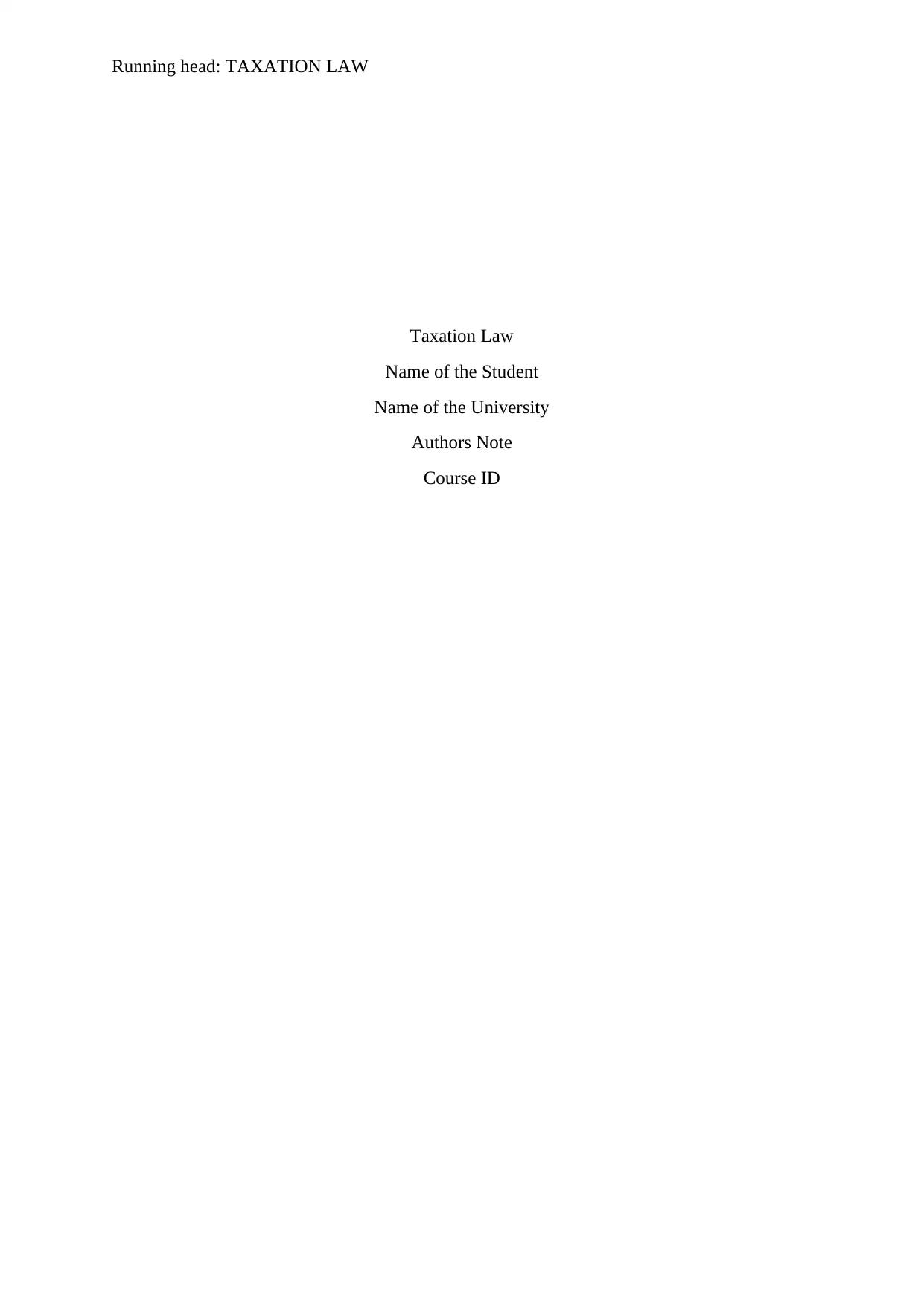
Running head: TAXATION LAW
Taxation Law
Name of the Student
Name of the University
Authors Note
Course ID
Taxation Law
Name of the Student
Name of the University
Authors Note
Course ID
Secure Best Marks with AI Grader
Need help grading? Try our AI Grader for instant feedback on your assignments.

1TAXATION LAW
Table of Contents
Facts of the Case:.......................................................................................................................2
Issues:.........................................................................................................................................2
Rule:...........................................................................................................................................2
Application:................................................................................................................................5
Conclusion:................................................................................................................................8
References..................................................................................................................................9
Table of Contents
Facts of the Case:.......................................................................................................................2
Issues:.........................................................................................................................................2
Rule:...........................................................................................................................................2
Application:................................................................................................................................5
Conclusion:................................................................................................................................8
References..................................................................................................................................9
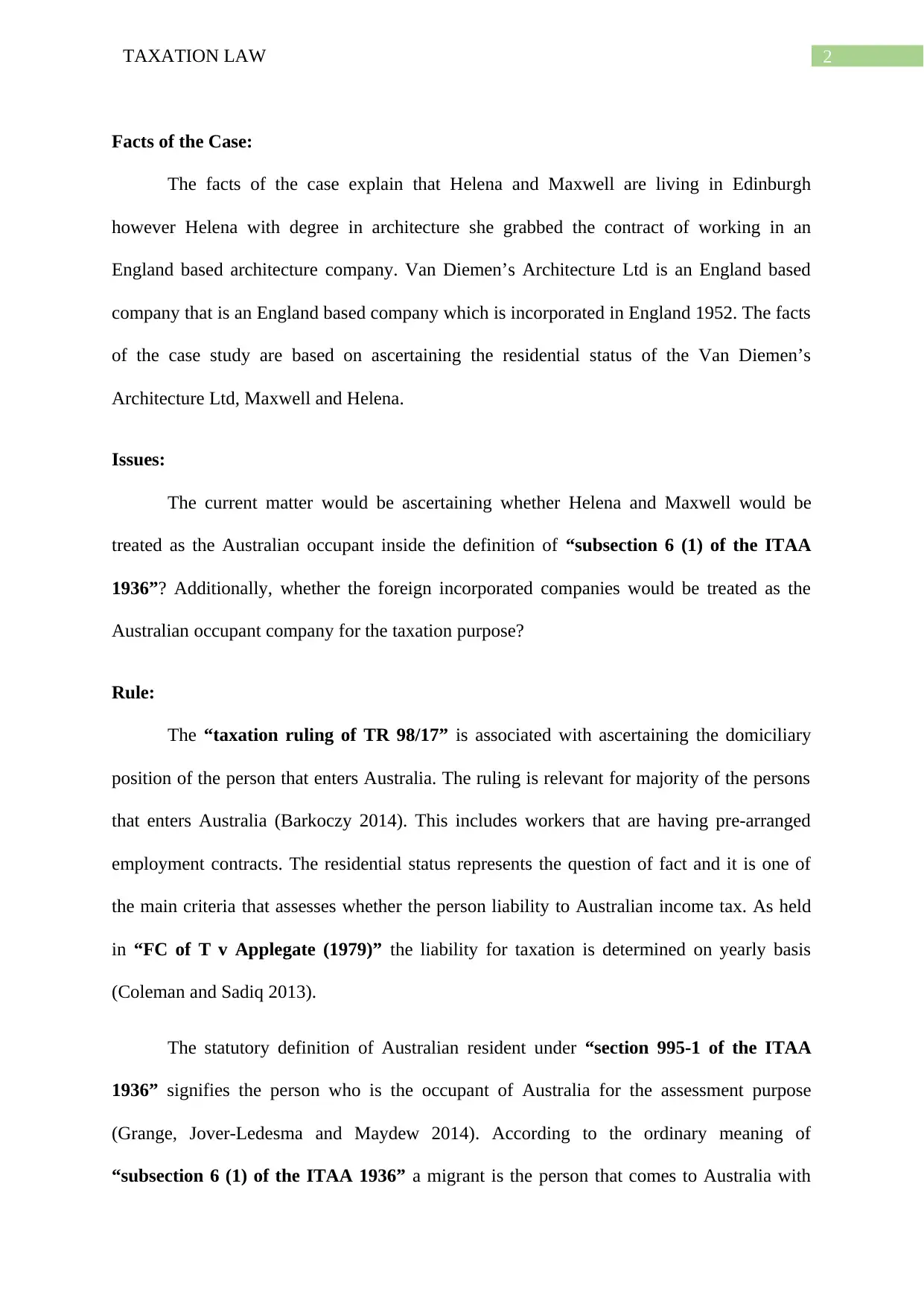
2TAXATION LAW
Facts of the Case:
The facts of the case explain that Helena and Maxwell are living in Edinburgh
however Helena with degree in architecture she grabbed the contract of working in an
England based architecture company. Van Diemen’s Architecture Ltd is an England based
company that is an England based company which is incorporated in England 1952. The facts
of the case study are based on ascertaining the residential status of the Van Diemen’s
Architecture Ltd, Maxwell and Helena.
Issues:
The current matter would be ascertaining whether Helena and Maxwell would be
treated as the Australian occupant inside the definition of “subsection 6 (1) of the ITAA
1936”? Additionally, whether the foreign incorporated companies would be treated as the
Australian occupant company for the taxation purpose?
Rule:
The “taxation ruling of TR 98/17” is associated with ascertaining the domiciliary
position of the person that enters Australia. The ruling is relevant for majority of the persons
that enters Australia (Barkoczy 2014). This includes workers that are having pre-arranged
employment contracts. The residential status represents the question of fact and it is one of
the main criteria that assesses whether the person liability to Australian income tax. As held
in “FC of T v Applegate (1979)” the liability for taxation is determined on yearly basis
(Coleman and Sadiq 2013).
The statutory definition of Australian resident under “section 995-1 of the ITAA
1936” signifies the person who is the occupant of Australia for the assessment purpose
(Grange, Jover-Ledesma and Maydew 2014). According to the ordinary meaning of
“subsection 6 (1) of the ITAA 1936” a migrant is the person that comes to Australia with
Facts of the Case:
The facts of the case explain that Helena and Maxwell are living in Edinburgh
however Helena with degree in architecture she grabbed the contract of working in an
England based architecture company. Van Diemen’s Architecture Ltd is an England based
company that is an England based company which is incorporated in England 1952. The facts
of the case study are based on ascertaining the residential status of the Van Diemen’s
Architecture Ltd, Maxwell and Helena.
Issues:
The current matter would be ascertaining whether Helena and Maxwell would be
treated as the Australian occupant inside the definition of “subsection 6 (1) of the ITAA
1936”? Additionally, whether the foreign incorporated companies would be treated as the
Australian occupant company for the taxation purpose?
Rule:
The “taxation ruling of TR 98/17” is associated with ascertaining the domiciliary
position of the person that enters Australia. The ruling is relevant for majority of the persons
that enters Australia (Barkoczy 2014). This includes workers that are having pre-arranged
employment contracts. The residential status represents the question of fact and it is one of
the main criteria that assesses whether the person liability to Australian income tax. As held
in “FC of T v Applegate (1979)” the liability for taxation is determined on yearly basis
(Coleman and Sadiq 2013).
The statutory definition of Australian resident under “section 995-1 of the ITAA
1936” signifies the person who is the occupant of Australia for the assessment purpose
(Grange, Jover-Ledesma and Maydew 2014). According to the ordinary meaning of
“subsection 6 (1) of the ITAA 1936” a migrant is the person that comes to Australia with
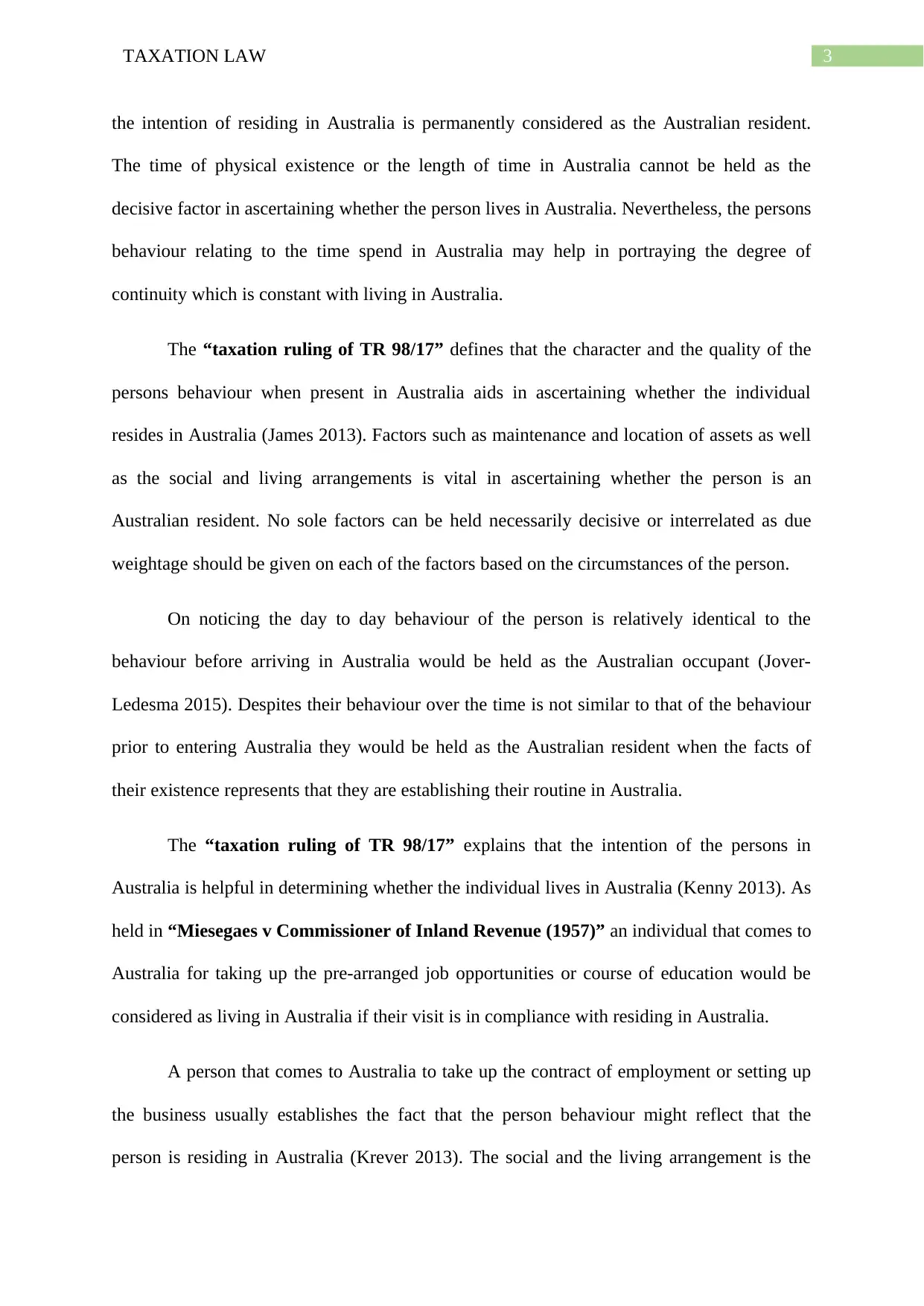
3TAXATION LAW
the intention of residing in Australia is permanently considered as the Australian resident.
The time of physical existence or the length of time in Australia cannot be held as the
decisive factor in ascertaining whether the person lives in Australia. Nevertheless, the persons
behaviour relating to the time spend in Australia may help in portraying the degree of
continuity which is constant with living in Australia.
The “taxation ruling of TR 98/17” defines that the character and the quality of the
persons behaviour when present in Australia aids in ascertaining whether the individual
resides in Australia (James 2013). Factors such as maintenance and location of assets as well
as the social and living arrangements is vital in ascertaining whether the person is an
Australian resident. No sole factors can be held necessarily decisive or interrelated as due
weightage should be given on each of the factors based on the circumstances of the person.
On noticing the day to day behaviour of the person is relatively identical to the
behaviour before arriving in Australia would be held as the Australian occupant (Jover-
Ledesma 2015). Despites their behaviour over the time is not similar to that of the behaviour
prior to entering Australia they would be held as the Australian resident when the facts of
their existence represents that they are establishing their routine in Australia.
The “taxation ruling of TR 98/17” explains that the intention of the persons in
Australia is helpful in determining whether the individual lives in Australia (Kenny 2013). As
held in “Miesegaes v Commissioner of Inland Revenue (1957)” an individual that comes to
Australia for taking up the pre-arranged job opportunities or course of education would be
considered as living in Australia if their visit is in compliance with residing in Australia.
A person that comes to Australia to take up the contract of employment or setting up
the business usually establishes the fact that the person behaviour might reflect that the
person is residing in Australia (Krever 2013). The social and the living arrangement is the
the intention of residing in Australia is permanently considered as the Australian resident.
The time of physical existence or the length of time in Australia cannot be held as the
decisive factor in ascertaining whether the person lives in Australia. Nevertheless, the persons
behaviour relating to the time spend in Australia may help in portraying the degree of
continuity which is constant with living in Australia.
The “taxation ruling of TR 98/17” defines that the character and the quality of the
persons behaviour when present in Australia aids in ascertaining whether the individual
resides in Australia (James 2013). Factors such as maintenance and location of assets as well
as the social and living arrangements is vital in ascertaining whether the person is an
Australian resident. No sole factors can be held necessarily decisive or interrelated as due
weightage should be given on each of the factors based on the circumstances of the person.
On noticing the day to day behaviour of the person is relatively identical to the
behaviour before arriving in Australia would be held as the Australian occupant (Jover-
Ledesma 2015). Despites their behaviour over the time is not similar to that of the behaviour
prior to entering Australia they would be held as the Australian resident when the facts of
their existence represents that they are establishing their routine in Australia.
The “taxation ruling of TR 98/17” explains that the intention of the persons in
Australia is helpful in determining whether the individual lives in Australia (Kenny 2013). As
held in “Miesegaes v Commissioner of Inland Revenue (1957)” an individual that comes to
Australia for taking up the pre-arranged job opportunities or course of education would be
considered as living in Australia if their visit is in compliance with residing in Australia.
A person that comes to Australia to take up the contract of employment or setting up
the business usually establishes the fact that the person behaviour might reflect that the
person is residing in Australia (Krever 2013). The social and the living arrangement is the
Secure Best Marks with AI Grader
Need help grading? Try our AI Grader for instant feedback on your assignments.
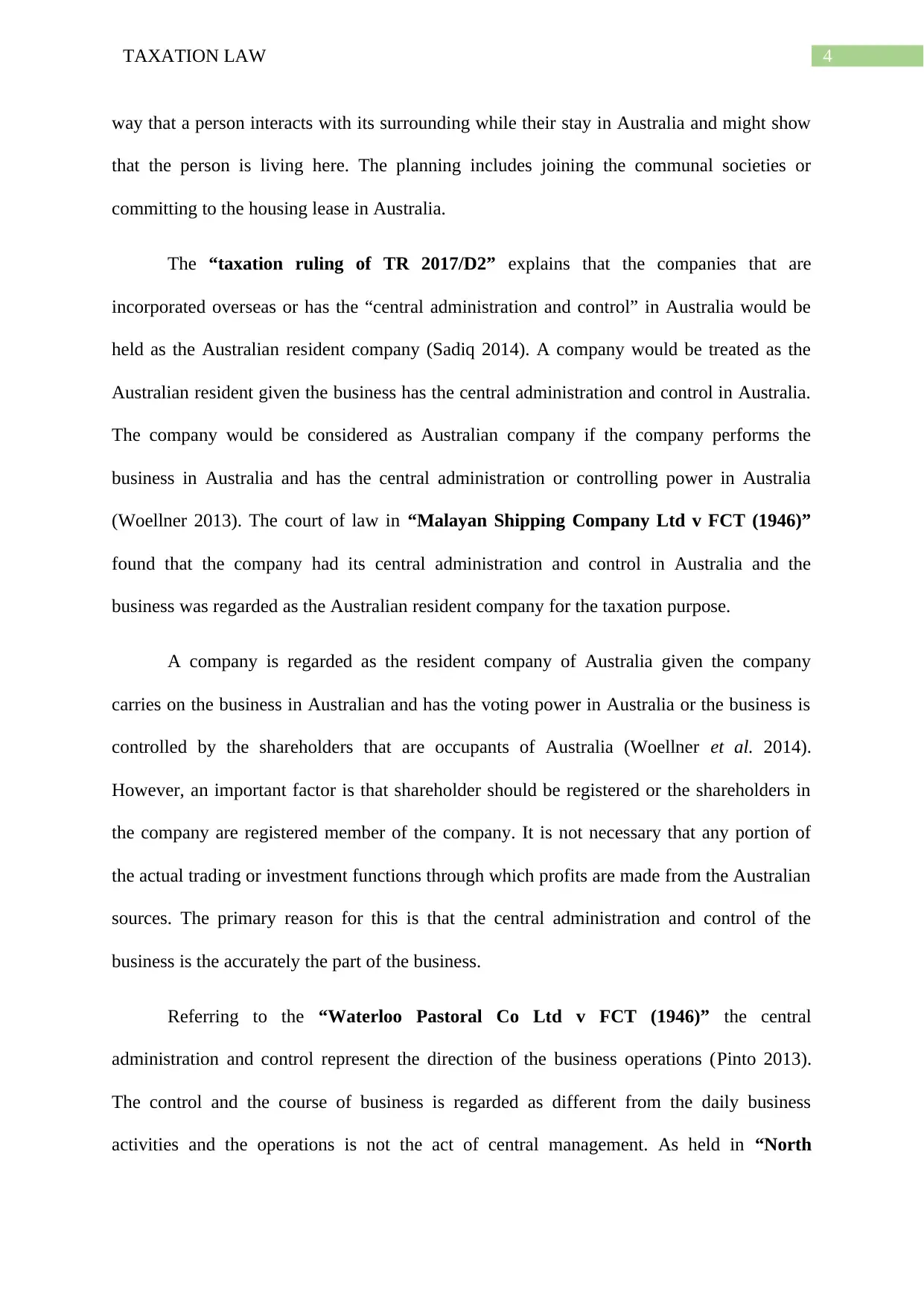
4TAXATION LAW
way that a person interacts with its surrounding while their stay in Australia and might show
that the person is living here. The planning includes joining the communal societies or
committing to the housing lease in Australia.
The “taxation ruling of TR 2017/D2” explains that the companies that are
incorporated overseas or has the “central administration and control” in Australia would be
held as the Australian resident company (Sadiq 2014). A company would be treated as the
Australian resident given the business has the central administration and control in Australia.
The company would be considered as Australian company if the company performs the
business in Australia and has the central administration or controlling power in Australia
(Woellner 2013). The court of law in “Malayan Shipping Company Ltd v FCT (1946)”
found that the company had its central administration and control in Australia and the
business was regarded as the Australian resident company for the taxation purpose.
A company is regarded as the resident company of Australia given the company
carries on the business in Australian and has the voting power in Australia or the business is
controlled by the shareholders that are occupants of Australia (Woellner et al. 2014).
However, an important factor is that shareholder should be registered or the shareholders in
the company are registered member of the company. It is not necessary that any portion of
the actual trading or investment functions through which profits are made from the Australian
sources. The primary reason for this is that the central administration and control of the
business is the accurately the part of the business.
Referring to the “Waterloo Pastoral Co Ltd v FCT (1946)” the central
administration and control represent the direction of the business operations (Pinto 2013).
The control and the course of business is regarded as different from the daily business
activities and the operations is not the act of central management. As held in “North
way that a person interacts with its surrounding while their stay in Australia and might show
that the person is living here. The planning includes joining the communal societies or
committing to the housing lease in Australia.
The “taxation ruling of TR 2017/D2” explains that the companies that are
incorporated overseas or has the “central administration and control” in Australia would be
held as the Australian resident company (Sadiq 2014). A company would be treated as the
Australian resident given the business has the central administration and control in Australia.
The company would be considered as Australian company if the company performs the
business in Australia and has the central administration or controlling power in Australia
(Woellner 2013). The court of law in “Malayan Shipping Company Ltd v FCT (1946)”
found that the company had its central administration and control in Australia and the
business was regarded as the Australian resident company for the taxation purpose.
A company is regarded as the resident company of Australia given the company
carries on the business in Australian and has the voting power in Australia or the business is
controlled by the shareholders that are occupants of Australia (Woellner et al. 2014).
However, an important factor is that shareholder should be registered or the shareholders in
the company are registered member of the company. It is not necessary that any portion of
the actual trading or investment functions through which profits are made from the Australian
sources. The primary reason for this is that the central administration and control of the
business is the accurately the part of the business.
Referring to the “Waterloo Pastoral Co Ltd v FCT (1946)” the central
administration and control represent the direction of the business operations (Pinto 2013).
The control and the course of business is regarded as different from the daily business
activities and the operations is not the act of central management. As held in “North
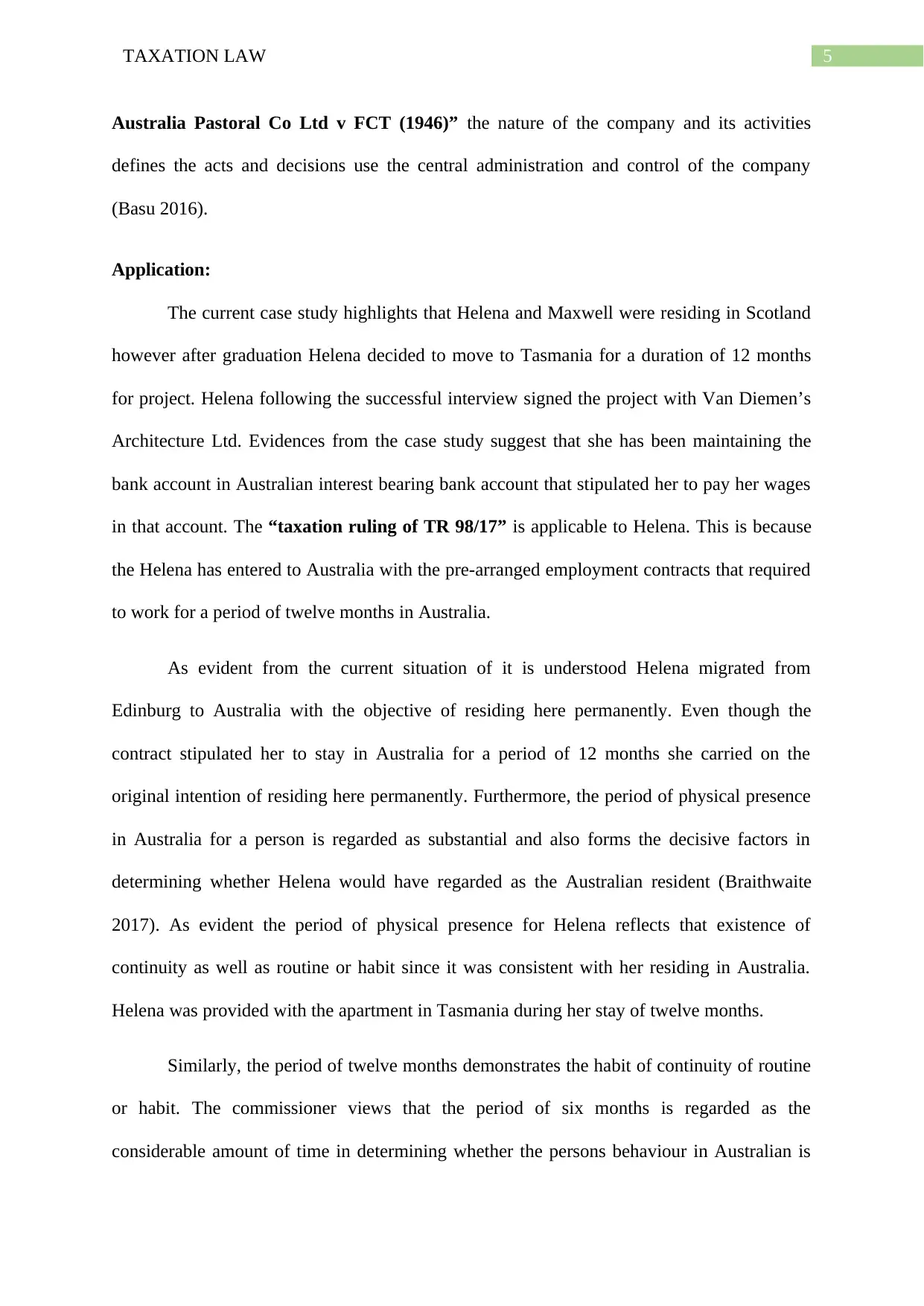
5TAXATION LAW
Australia Pastoral Co Ltd v FCT (1946)” the nature of the company and its activities
defines the acts and decisions use the central administration and control of the company
(Basu 2016).
Application:
The current case study highlights that Helena and Maxwell were residing in Scotland
however after graduation Helena decided to move to Tasmania for a duration of 12 months
for project. Helena following the successful interview signed the project with Van Diemen’s
Architecture Ltd. Evidences from the case study suggest that she has been maintaining the
bank account in Australian interest bearing bank account that stipulated her to pay her wages
in that account. The “taxation ruling of TR 98/17” is applicable to Helena. This is because
the Helena has entered to Australia with the pre-arranged employment contracts that required
to work for a period of twelve months in Australia.
As evident from the current situation of it is understood Helena migrated from
Edinburg to Australia with the objective of residing here permanently. Even though the
contract stipulated her to stay in Australia for a period of 12 months she carried on the
original intention of residing here permanently. Furthermore, the period of physical presence
in Australia for a person is regarded as substantial and also forms the decisive factors in
determining whether Helena would have regarded as the Australian resident (Braithwaite
2017). As evident the period of physical presence for Helena reflects that existence of
continuity as well as routine or habit since it was consistent with her residing in Australia.
Helena was provided with the apartment in Tasmania during her stay of twelve months.
Similarly, the period of twelve months demonstrates the habit of continuity of routine
or habit. The commissioner views that the period of six months is regarded as the
considerable amount of time in determining whether the persons behaviour in Australian is
Australia Pastoral Co Ltd v FCT (1946)” the nature of the company and its activities
defines the acts and decisions use the central administration and control of the company
(Basu 2016).
Application:
The current case study highlights that Helena and Maxwell were residing in Scotland
however after graduation Helena decided to move to Tasmania for a duration of 12 months
for project. Helena following the successful interview signed the project with Van Diemen’s
Architecture Ltd. Evidences from the case study suggest that she has been maintaining the
bank account in Australian interest bearing bank account that stipulated her to pay her wages
in that account. The “taxation ruling of TR 98/17” is applicable to Helena. This is because
the Helena has entered to Australia with the pre-arranged employment contracts that required
to work for a period of twelve months in Australia.
As evident from the current situation of it is understood Helena migrated from
Edinburg to Australia with the objective of residing here permanently. Even though the
contract stipulated her to stay in Australia for a period of 12 months she carried on the
original intention of residing here permanently. Furthermore, the period of physical presence
in Australia for a person is regarded as substantial and also forms the decisive factors in
determining whether Helena would have regarded as the Australian resident (Braithwaite
2017). As evident the period of physical presence for Helena reflects that existence of
continuity as well as routine or habit since it was consistent with her residing in Australia.
Helena was provided with the apartment in Tasmania during her stay of twelve months.
Similarly, the period of twelve months demonstrates the habit of continuity of routine
or habit. The commissioner views that the period of six months is regarded as the
considerable amount of time in determining whether the persons behaviour in Australian is

6TAXATION LAW
consistent with residing in Australia. Helena’s period of twelve months reflects that her
behaviour of 12 months demonstrates the period of continuity as she even established a bank
account in Australian based interest bearing bank with the continuous intention of residing in
Australia.
Referring to the case of “Miesegaes v Commissioner of Inland Revenue (1957)” it
can be stated that Helena came to Australia with the original intention of residing in
Australia. In the later instances of the case study it is noticed that Helena also involved
herself in the community charity program. Referring to the “taxation ruling of TR 98/17” it
can be stated that the quality and the character of the Helena’s presence in Australia defines
her social and living arrangement with the country (Snape and De Souza 2016). Helena
indulgence in charity provides an assistance in determining that her behaviour is consistence
with residing in Australia.
Instances obtained from the case study explains that Van Diemen’s Architecture Ltd
experienced growth in business which resulted in offering a permanent position in the
company. Under the definition of “subsection 6 (1) of the ITAA 1936” it can be stated that
Helena is a resident of Australia since she has accepted the offer of staying permanently here
(Blakelock and King 2017). Furthermore, the quality and the character of behaviour
represents that manner of domestic and economic continuity for their lives. Furthermore,
Helena day-to-day behaviour is consistent with the behaviour before coming to Australia as it
is most probable to be held as the Australian occupant. Her intention as well as the purpose
for being in Australia also reflected a continuity of presence. Citing the reference of
“Miesegaes v Commissioner of Inland Revenue (1957)” Helena entered to Australia with
the pre-arranged employment contract and her stay was in consistent with residing in
Australia.
consistent with residing in Australia. Helena’s period of twelve months reflects that her
behaviour of 12 months demonstrates the period of continuity as she even established a bank
account in Australian based interest bearing bank with the continuous intention of residing in
Australia.
Referring to the case of “Miesegaes v Commissioner of Inland Revenue (1957)” it
can be stated that Helena came to Australia with the original intention of residing in
Australia. In the later instances of the case study it is noticed that Helena also involved
herself in the community charity program. Referring to the “taxation ruling of TR 98/17” it
can be stated that the quality and the character of the Helena’s presence in Australia defines
her social and living arrangement with the country (Snape and De Souza 2016). Helena
indulgence in charity provides an assistance in determining that her behaviour is consistence
with residing in Australia.
Instances obtained from the case study explains that Van Diemen’s Architecture Ltd
experienced growth in business which resulted in offering a permanent position in the
company. Under the definition of “subsection 6 (1) of the ITAA 1936” it can be stated that
Helena is a resident of Australia since she has accepted the offer of staying permanently here
(Blakelock and King 2017). Furthermore, the quality and the character of behaviour
represents that manner of domestic and economic continuity for their lives. Furthermore,
Helena day-to-day behaviour is consistent with the behaviour before coming to Australia as it
is most probable to be held as the Australian occupant. Her intention as well as the purpose
for being in Australia also reflected a continuity of presence. Citing the reference of
“Miesegaes v Commissioner of Inland Revenue (1957)” Helena entered to Australia with
the pre-arranged employment contract and her stay was in consistent with residing in
Australia.
Paraphrase This Document
Need a fresh take? Get an instant paraphrase of this document with our AI Paraphraser
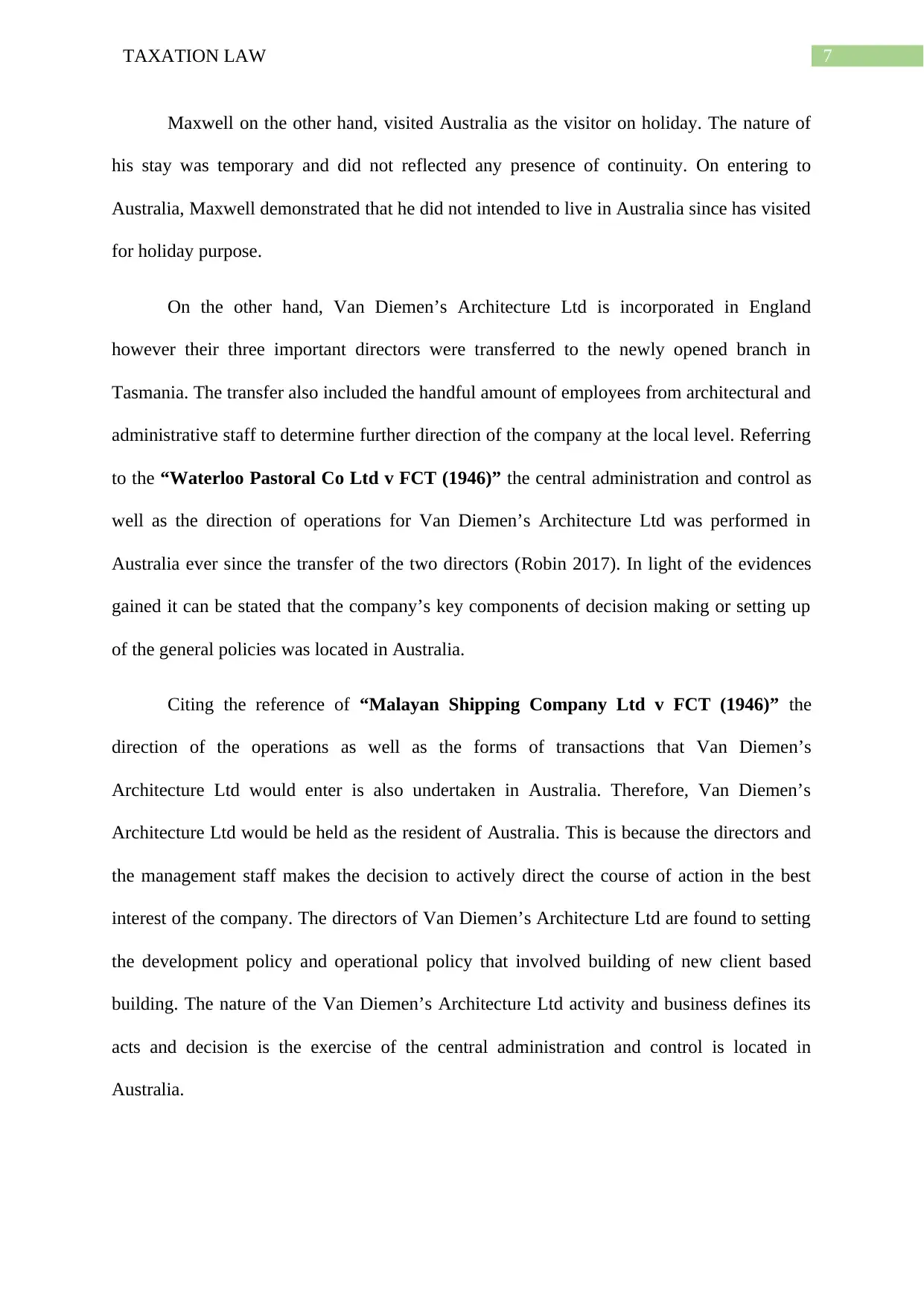
7TAXATION LAW
Maxwell on the other hand, visited Australia as the visitor on holiday. The nature of
his stay was temporary and did not reflected any presence of continuity. On entering to
Australia, Maxwell demonstrated that he did not intended to live in Australia since has visited
for holiday purpose.
On the other hand, Van Diemen’s Architecture Ltd is incorporated in England
however their three important directors were transferred to the newly opened branch in
Tasmania. The transfer also included the handful amount of employees from architectural and
administrative staff to determine further direction of the company at the local level. Referring
to the “Waterloo Pastoral Co Ltd v FCT (1946)” the central administration and control as
well as the direction of operations for Van Diemen’s Architecture Ltd was performed in
Australia ever since the transfer of the two directors (Robin 2017). In light of the evidences
gained it can be stated that the company’s key components of decision making or setting up
of the general policies was located in Australia.
Citing the reference of “Malayan Shipping Company Ltd v FCT (1946)” the
direction of the operations as well as the forms of transactions that Van Diemen’s
Architecture Ltd would enter is also undertaken in Australia. Therefore, Van Diemen’s
Architecture Ltd would be held as the resident of Australia. This is because the directors and
the management staff makes the decision to actively direct the course of action in the best
interest of the company. The directors of Van Diemen’s Architecture Ltd are found to setting
the development policy and operational policy that involved building of new client based
building. The nature of the Van Diemen’s Architecture Ltd activity and business defines its
acts and decision is the exercise of the central administration and control is located in
Australia.
Maxwell on the other hand, visited Australia as the visitor on holiday. The nature of
his stay was temporary and did not reflected any presence of continuity. On entering to
Australia, Maxwell demonstrated that he did not intended to live in Australia since has visited
for holiday purpose.
On the other hand, Van Diemen’s Architecture Ltd is incorporated in England
however their three important directors were transferred to the newly opened branch in
Tasmania. The transfer also included the handful amount of employees from architectural and
administrative staff to determine further direction of the company at the local level. Referring
to the “Waterloo Pastoral Co Ltd v FCT (1946)” the central administration and control as
well as the direction of operations for Van Diemen’s Architecture Ltd was performed in
Australia ever since the transfer of the two directors (Robin 2017). In light of the evidences
gained it can be stated that the company’s key components of decision making or setting up
of the general policies was located in Australia.
Citing the reference of “Malayan Shipping Company Ltd v FCT (1946)” the
direction of the operations as well as the forms of transactions that Van Diemen’s
Architecture Ltd would enter is also undertaken in Australia. Therefore, Van Diemen’s
Architecture Ltd would be held as the resident of Australia. This is because the directors and
the management staff makes the decision to actively direct the course of action in the best
interest of the company. The directors of Van Diemen’s Architecture Ltd are found to setting
the development policy and operational policy that involved building of new client based
building. The nature of the Van Diemen’s Architecture Ltd activity and business defines its
acts and decision is the exercise of the central administration and control is located in
Australia.
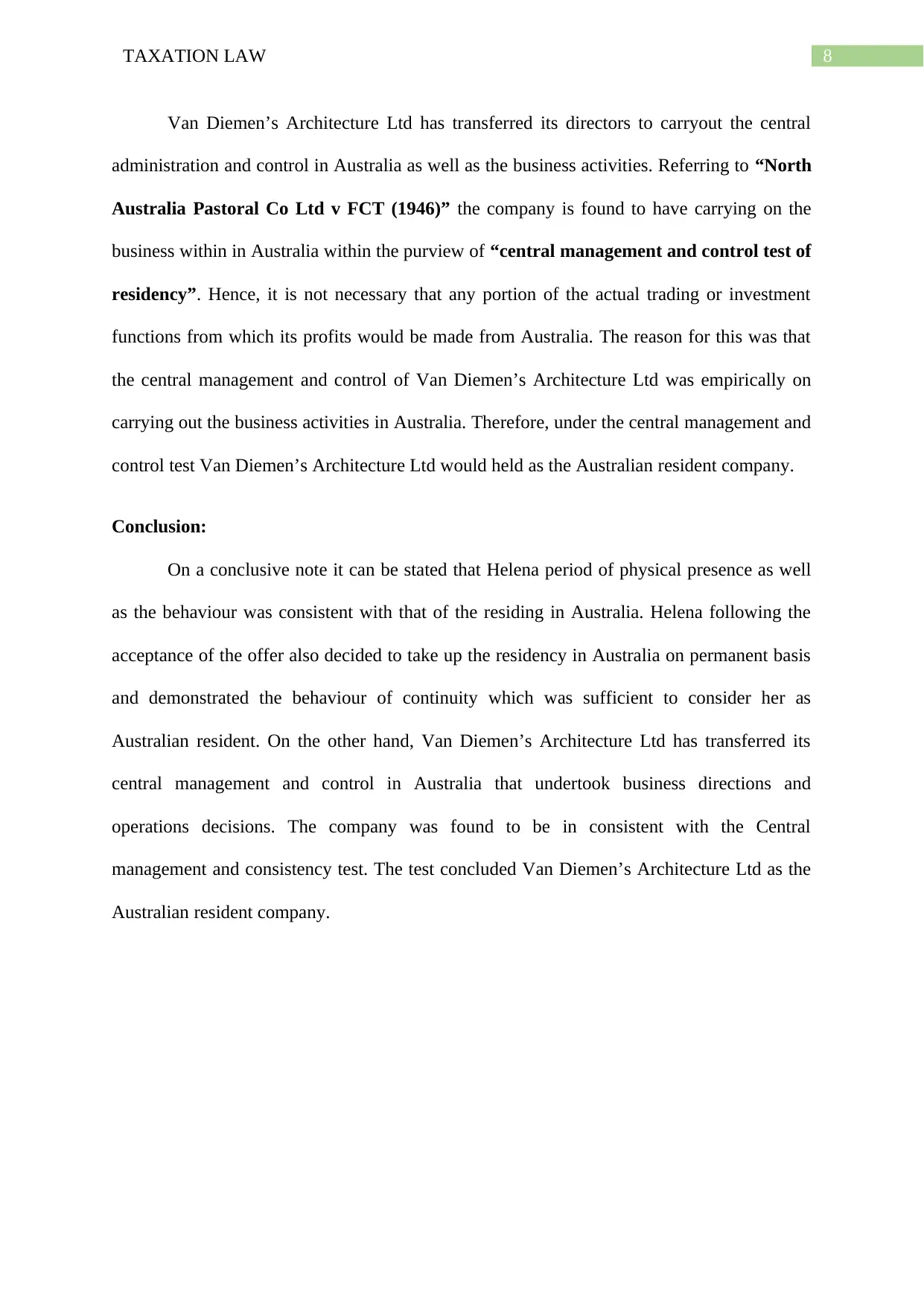
8TAXATION LAW
Van Diemen’s Architecture Ltd has transferred its directors to carryout the central
administration and control in Australia as well as the business activities. Referring to “North
Australia Pastoral Co Ltd v FCT (1946)” the company is found to have carrying on the
business within in Australia within the purview of “central management and control test of
residency”. Hence, it is not necessary that any portion of the actual trading or investment
functions from which its profits would be made from Australia. The reason for this was that
the central management and control of Van Diemen’s Architecture Ltd was empirically on
carrying out the business activities in Australia. Therefore, under the central management and
control test Van Diemen’s Architecture Ltd would held as the Australian resident company.
Conclusion:
On a conclusive note it can be stated that Helena period of physical presence as well
as the behaviour was consistent with that of the residing in Australia. Helena following the
acceptance of the offer also decided to take up the residency in Australia on permanent basis
and demonstrated the behaviour of continuity which was sufficient to consider her as
Australian resident. On the other hand, Van Diemen’s Architecture Ltd has transferred its
central management and control in Australia that undertook business directions and
operations decisions. The company was found to be in consistent with the Central
management and consistency test. The test concluded Van Diemen’s Architecture Ltd as the
Australian resident company.
Van Diemen’s Architecture Ltd has transferred its directors to carryout the central
administration and control in Australia as well as the business activities. Referring to “North
Australia Pastoral Co Ltd v FCT (1946)” the company is found to have carrying on the
business within in Australia within the purview of “central management and control test of
residency”. Hence, it is not necessary that any portion of the actual trading or investment
functions from which its profits would be made from Australia. The reason for this was that
the central management and control of Van Diemen’s Architecture Ltd was empirically on
carrying out the business activities in Australia. Therefore, under the central management and
control test Van Diemen’s Architecture Ltd would held as the Australian resident company.
Conclusion:
On a conclusive note it can be stated that Helena period of physical presence as well
as the behaviour was consistent with that of the residing in Australia. Helena following the
acceptance of the offer also decided to take up the residency in Australia on permanent basis
and demonstrated the behaviour of continuity which was sufficient to consider her as
Australian resident. On the other hand, Van Diemen’s Architecture Ltd has transferred its
central management and control in Australia that undertook business directions and
operations decisions. The company was found to be in consistent with the Central
management and consistency test. The test concluded Van Diemen’s Architecture Ltd as the
Australian resident company.
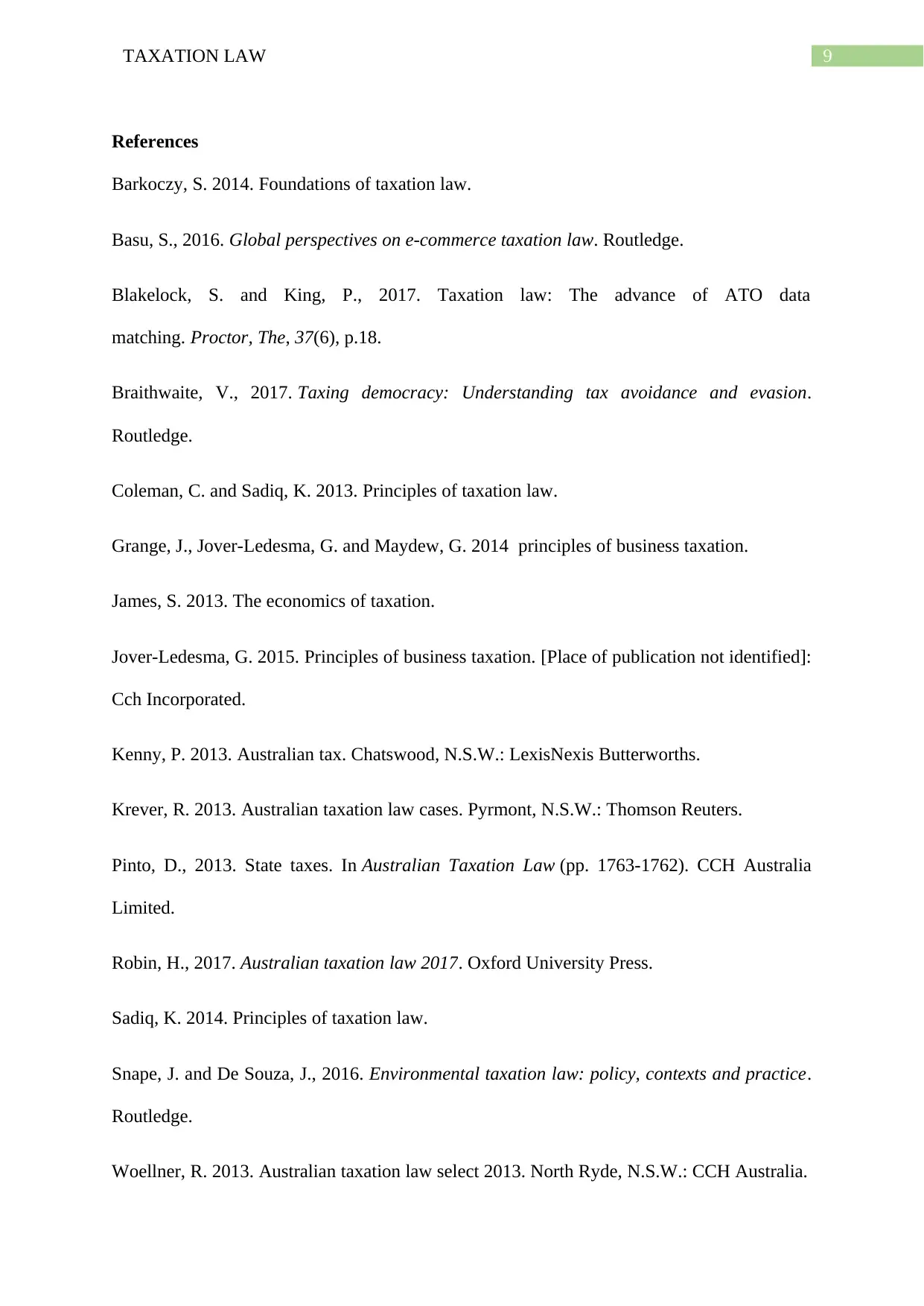
9TAXATION LAW
References
Barkoczy, S. 2014. Foundations of taxation law.
Basu, S., 2016. Global perspectives on e-commerce taxation law. Routledge.
Blakelock, S. and King, P., 2017. Taxation law: The advance of ATO data
matching. Proctor, The, 37(6), p.18.
Braithwaite, V., 2017. Taxing democracy: Understanding tax avoidance and evasion.
Routledge.
Coleman, C. and Sadiq, K. 2013. Principles of taxation law.
Grange, J., Jover-Ledesma, G. and Maydew, G. 2014 principles of business taxation.
James, S. 2013. The economics of taxation.
Jover-Ledesma, G. 2015. Principles of business taxation. [Place of publication not identified]:
Cch Incorporated.
Kenny, P. 2013. Australian tax. Chatswood, N.S.W.: LexisNexis Butterworths.
Krever, R. 2013. Australian taxation law cases. Pyrmont, N.S.W.: Thomson Reuters.
Pinto, D., 2013. State taxes. In Australian Taxation Law (pp. 1763-1762). CCH Australia
Limited.
Robin, H., 2017. Australian taxation law 2017. Oxford University Press.
Sadiq, K. 2014. Principles of taxation law.
Snape, J. and De Souza, J., 2016. Environmental taxation law: policy, contexts and practice.
Routledge.
Woellner, R. 2013. Australian taxation law select 2013. North Ryde, N.S.W.: CCH Australia.
References
Barkoczy, S. 2014. Foundations of taxation law.
Basu, S., 2016. Global perspectives on e-commerce taxation law. Routledge.
Blakelock, S. and King, P., 2017. Taxation law: The advance of ATO data
matching. Proctor, The, 37(6), p.18.
Braithwaite, V., 2017. Taxing democracy: Understanding tax avoidance and evasion.
Routledge.
Coleman, C. and Sadiq, K. 2013. Principles of taxation law.
Grange, J., Jover-Ledesma, G. and Maydew, G. 2014 principles of business taxation.
James, S. 2013. The economics of taxation.
Jover-Ledesma, G. 2015. Principles of business taxation. [Place of publication not identified]:
Cch Incorporated.
Kenny, P. 2013. Australian tax. Chatswood, N.S.W.: LexisNexis Butterworths.
Krever, R. 2013. Australian taxation law cases. Pyrmont, N.S.W.: Thomson Reuters.
Pinto, D., 2013. State taxes. In Australian Taxation Law (pp. 1763-1762). CCH Australia
Limited.
Robin, H., 2017. Australian taxation law 2017. Oxford University Press.
Sadiq, K. 2014. Principles of taxation law.
Snape, J. and De Souza, J., 2016. Environmental taxation law: policy, contexts and practice.
Routledge.
Woellner, R. 2013. Australian taxation law select 2013. North Ryde, N.S.W.: CCH Australia.
Secure Best Marks with AI Grader
Need help grading? Try our AI Grader for instant feedback on your assignments.
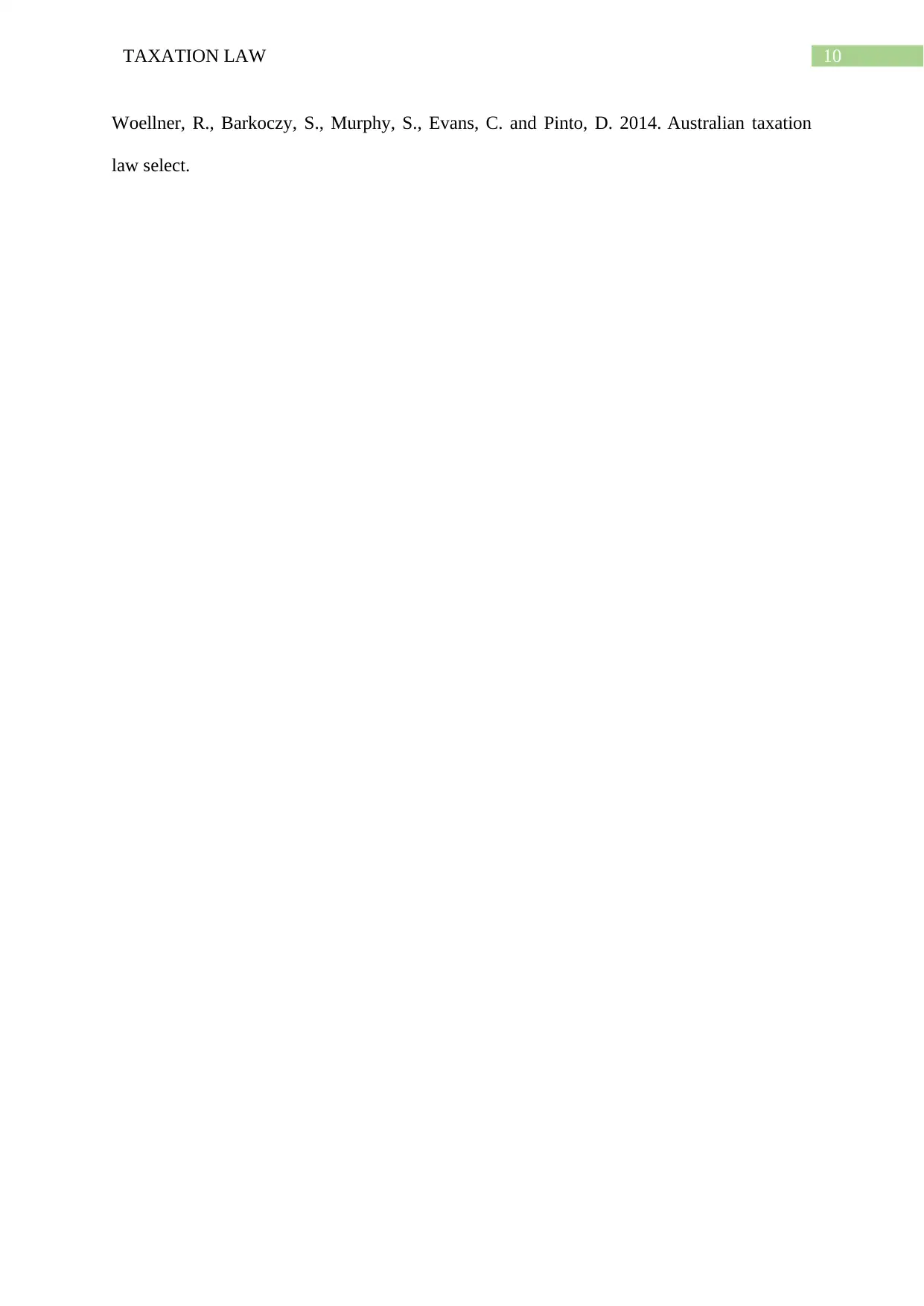
10TAXATION LAW
Woellner, R., Barkoczy, S., Murphy, S., Evans, C. and Pinto, D. 2014. Australian taxation
law select.
Woellner, R., Barkoczy, S., Murphy, S., Evans, C. and Pinto, D. 2014. Australian taxation
law select.
1 out of 11
Related Documents
Your All-in-One AI-Powered Toolkit for Academic Success.
+13062052269
info@desklib.com
Available 24*7 on WhatsApp / Email
![[object Object]](/_next/static/media/star-bottom.7253800d.svg)
Unlock your academic potential
© 2024 | Zucol Services PVT LTD | All rights reserved.





